One incredibly popular houseplant right now is the Monstera Deliciosa! Between its stunning giant leaves with holes like swiss cheese and unique aerial roots, this plant will be quite the showstopper in any home.
If you’re looking for how to care for monstera plants, you’ve come to the right place. We’ll share everything you need to know for happy, healthy plants!
Like most plants, the Monstera has a ton of different names, most commonly Monstera Deliciosa and the Swiss Cheese Plant! Another common name for this plant is Mexican breadfruit and hurricane plant.
Regardless of the name, when you see the leaves of these plants, you’ll understand why it can get the name “swiss cheese”.
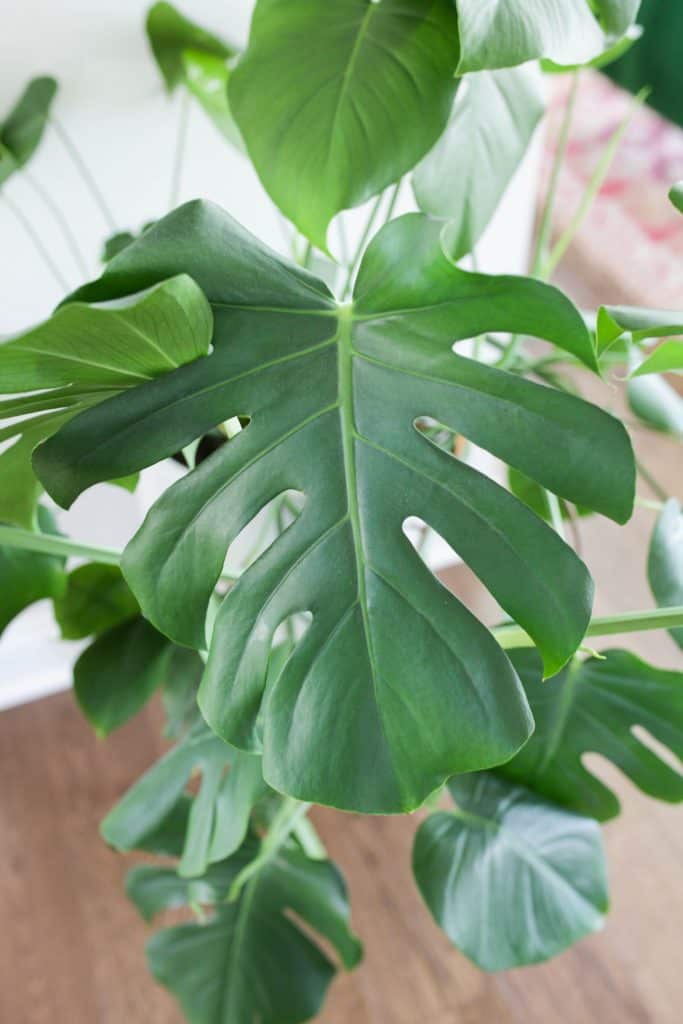
You’ve probably seen these plants all over and may have not even realized it. They’re on art, pillows, wallpaper and more! They’re tropical plants but can easily be grown as indoor plants regardless of where you live.
Monstera plants are great beginner plants. They’re incredibly hardy, need a good amount of bright indirect light and consistent watering (about once a week or so). Keep reading as we share about the background of this plant and everything to know about how to care for monstera plants!
Table of Contents
Monstera Plant Basics
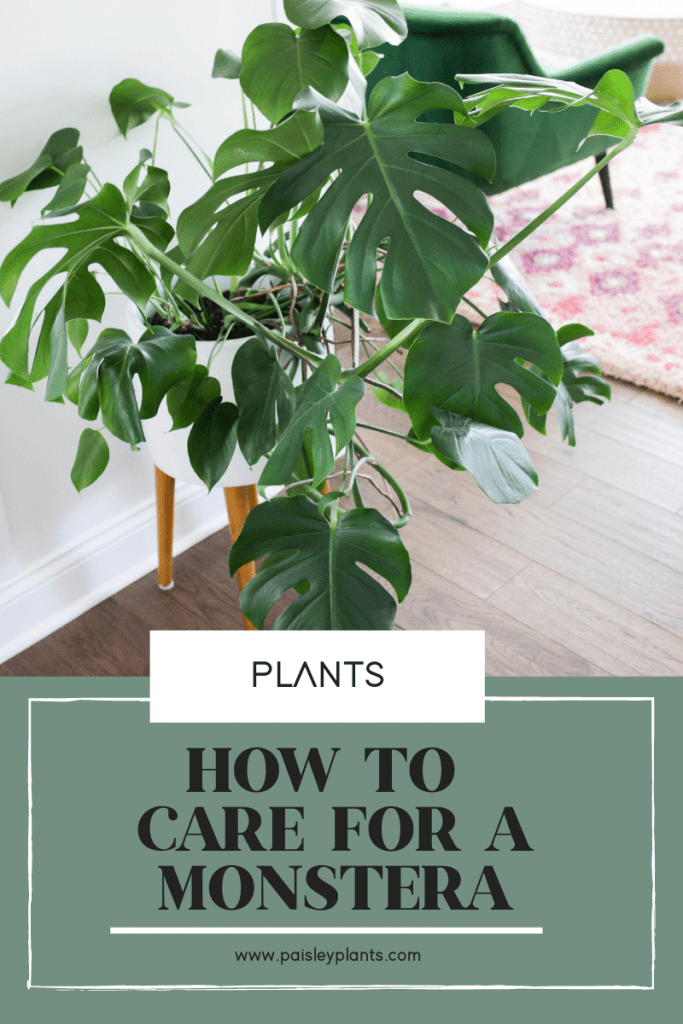
Paisley Plants is a participant in the Amazon Services LLC Associates Program, an affiliate advertising program. This post may include affiliate links which means I may earn a small commission if you shop using the links below at no additional cost to you.
Monstera plants are a tropical plant that’s native to the rain forests of Mexico, South America and Central America. If you find them in the wild you’ll notice two unique things. One is that they actually produce flowers and edible fruit!
The other thing is you’ll see that they climb up trees. They use their aerial roots to attach themselves to trees and bring themselves up closer to the tops of the trees, reaching for light.
Newer leaves are more heart shaped and as they grow they turn into more of a large palm like tree with holes. As the plant matures the more holes it gets.
There are a couple theories about why Monstera leaves has holes. One is that it helps them to withstand the massive rainfall in the rain forest without getting damaged. The other is that it helps sunlight and water reach the bottom of the plant when it’s in it’s natural habitat.
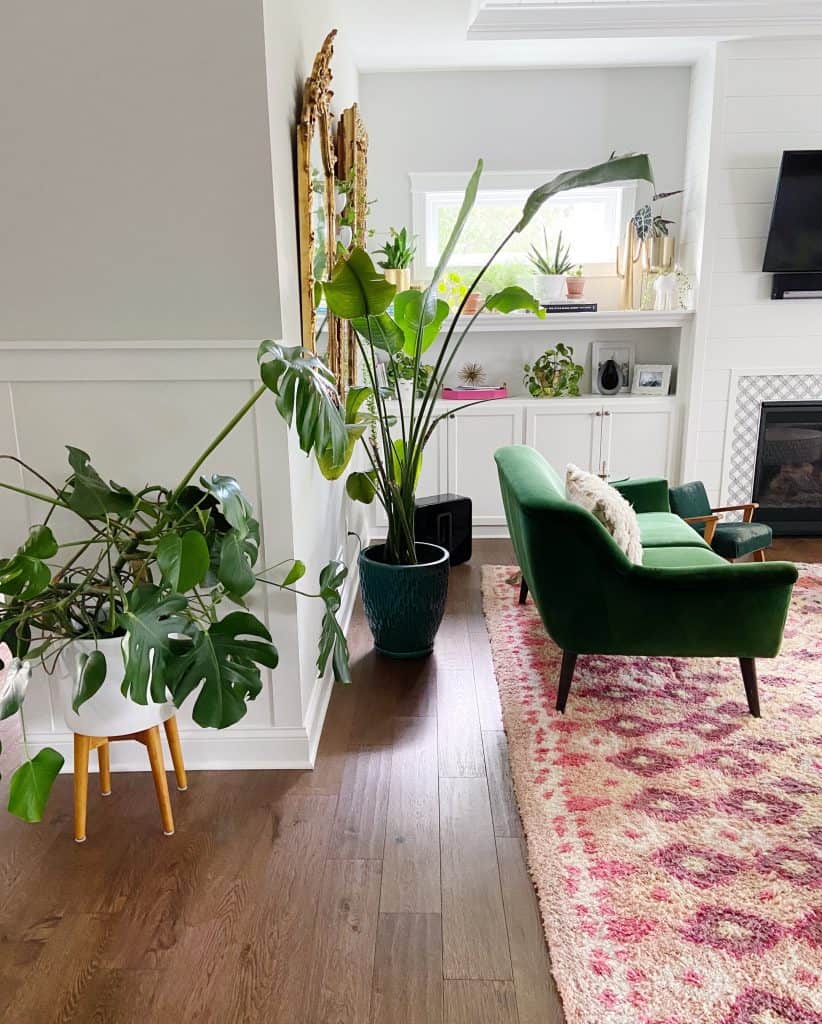
There are 48 species of monstera (and no, a Split Leaf Philodendron is not one of them)! I personally own 2 – a Monstera adansonii and a Monstera Deliciosa.
Something I love about the Monstera Adansonii is the size of the holes! This one is a smaller version of the monstera deliciosa but the holes makes up about 50% of the plant. There’s also a beautiful variegated version that looks looks like it was painted white with a paintbrush.
Monstera Plant Care Tips
Overall, monsteras are super easy to grow and care for. We would recommend this to even a beginner since there’s not much of a learning curve and they’re super hardy!
Water
Monsteras typically like to be watered about once a week, assuming it needs it. They’ll typically need less water during the winter months. The best trick is to stick your finger in the soil – if the top few inches are dry go ahead and water it.
If it’s still a little wet, leave it alone for a few days before check it again! They don’t like to be too wet or too dry so be sure to keep an eye on them.
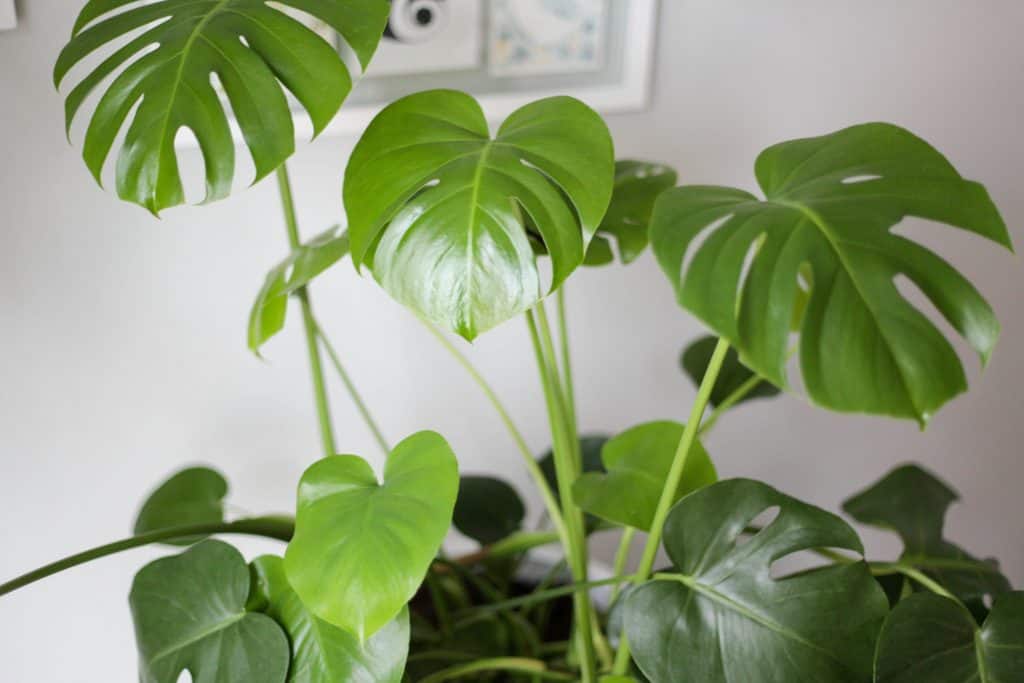
Monstera plants do best with filtered water. This doesn’t necessarily mean you need to purchase filtered water just for your plants! Simply fill up your watering can with water and leave it out overnight. This neutralizes it and allows the chlorine to evaporate.
Ideally Monsteras do best in pots with drainage holes (like most plants) but I currently have both of mine in pots without drainage holes and it’s thriving! Each plant is different, though, so start with a pot with drainage holes if you have one.
It’s always best to under water than to give your monstera too much water. If you’re nervous about not knowing how much to water it, you can always use a moisture meter! Just a few dollars will give a lot of peace of mind.
Light
Monstera do best with filtered bright indirect sunlight. They can also adapt to low light situations but they’ll grow bigger and better with indirect light!
Be careful not to give your monstera too harsh of sunlight or too much bright direct light or the leaves can get scorched and turn yellow. The last thing you want is to get burn marks on its leaves!
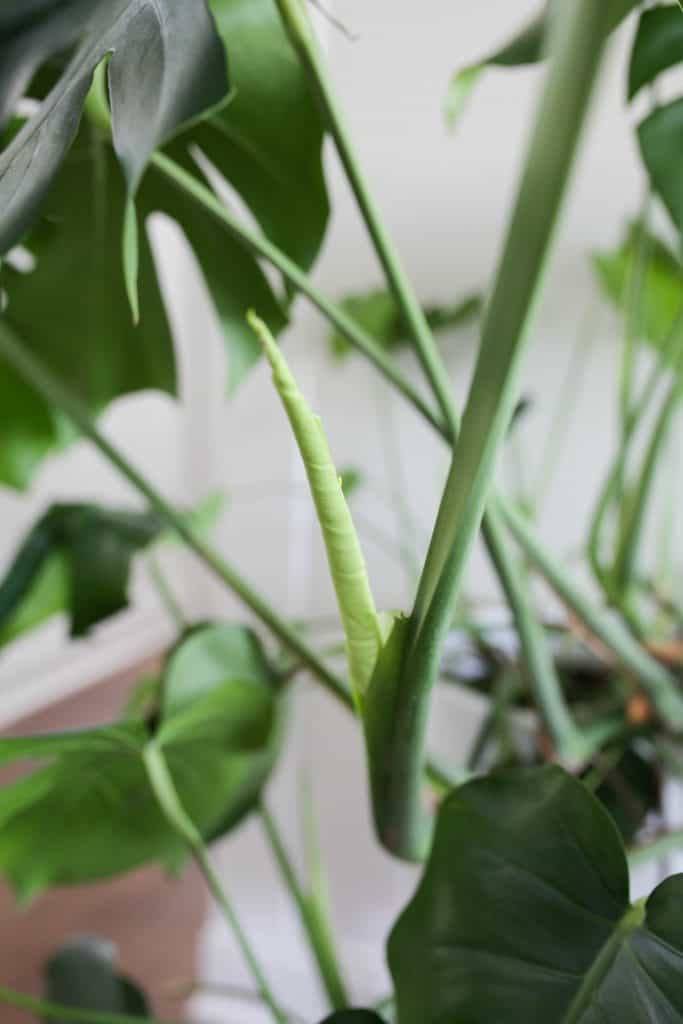
We have one of ours near an east facing windows that gets light through a curtain. We’ve had it for months now and it’s doing amazing!
We also have another one in a darker corner that get an ok amount of sunlight, also from the east. This one is full of clippings that I propagated. That one is also doing amazing!
Alternatively, if they don’t get enough light the leaves will start reaching towards the darkness (something that apparently happens in the jungle!).
Soil
Monstera plants need soil that’s well draining. They like moist soil but don’t do well siting in wetness so be sure to use a good indoor potting soil that is well-draining.
Using a pot with a drainage hole at the bottom of the pot will also encourage good drainage and prevent root rot. Always remember to empty the excess water from the tray under your pot so it doesn’t soak back up into your plant!
Temperature and Humidity
Monstera plants, being tropical plants, love humidity! If you have a humid spot, like a bathroom, (making this a perfect bathroom plant!) place them in there. If not, you can place a humidifier by your monstera or mist it often to mimic that tropical, humid environment.
You would think being tropical plants, that monsteras need hot places to live. But that’s not true! They will do fine in normal temperature homes! No need to turn the heat up for your new plant. The only thing to keep in mind is drastic temperature changes or cold drafts. Be sure to steer clear from a drafty or cold spot. Monsteras are sensitive to too cold temperatures so keep them away from cold temperatures!
Fertilizer
Monsteras are a simple plant that don’t need a lot of fertilizer. In fact, I didn’t use fertilizer for the first year after getting my new plant!
If you do fertilize your plant, it’s best to do so about once a month during spring and summer (it’s growing time) and not at all during fall and winter months. I love the J R Peters Classic All Purpose fertilizer for many of my plants.
Cleaning
Did you know that you should clean your plants leaves? Yep, it’s true! Especially plants with large leaves like Monstera plants. This helps them be able to get all the necessary nutrients through their leaves.
*Find 8 more big leaf plants that you need in your life!

All you need to do is get a damp cloth and simply clean the top and bottom of your plants’ leaves. This not only allows the plant to carry out photosynthesis but it also gives you a minute to examine your plant and check for bugs, spider mites or any other issues. Finding them early and taking care of them right away will help them to not become a problem later on!
Repotting
Monsteras are fast growing plants. When you first pot your plant you’ll want to choose a pot that’s slightly bigger than the nursery pot it came in. This will allow it to grow and mature easily.
Ideally you’ll want to repot your monstera about every 2 years. Doing this will encourage your plant to keep growing and not get stunted or overgrow it’s pot.
If you find yourself not wanting to get a bigger pot, you can always prune or propagate your monsera! This will help it from getting too large. Even if you don’t want another monstera plant, consider propagating it. You can easily gift the freshly rooted clippings to friends or neighbors.
Monsteras need a lot of room. Don’t try to crowd them in a corner in a high traffic area. We had ours near our dogs kennel for a while and as it grew the leaves got damaged from the dog and kids walking past it so often. Give it ample space (or trim it often) to help it stay healthy and looking beautiful.
Monsteras are natural climbers so you can add a small trellis, moss pole or stick near your plant for it to climb. If you don’t, they’ll likely just grow horizontally.
Toxicity
One thing to note is if you have a dog or cat, be warned that according to the ASPCA, monstera plants are toxic to dogs and cats as well as people. Don’t worry, it’s not fatal but keep it away from furry pets and small children.
Common Issues
Your leaves aren’t producing holes
If your monstera isn’t producing holes, it’s likely getting too much sun! Remember, one theory is that mature monstera leaves produce holes to provide sun to lower leaves. If the whole plant is getting ample sun, you may not get many leaves.
You monstera leaves are turning yellow
On the contrary, if your monstera leaves are turning yellow it means it’s not getting enough light. Move it closer to a window to give it bright, indirect sunlight and see if that helps.
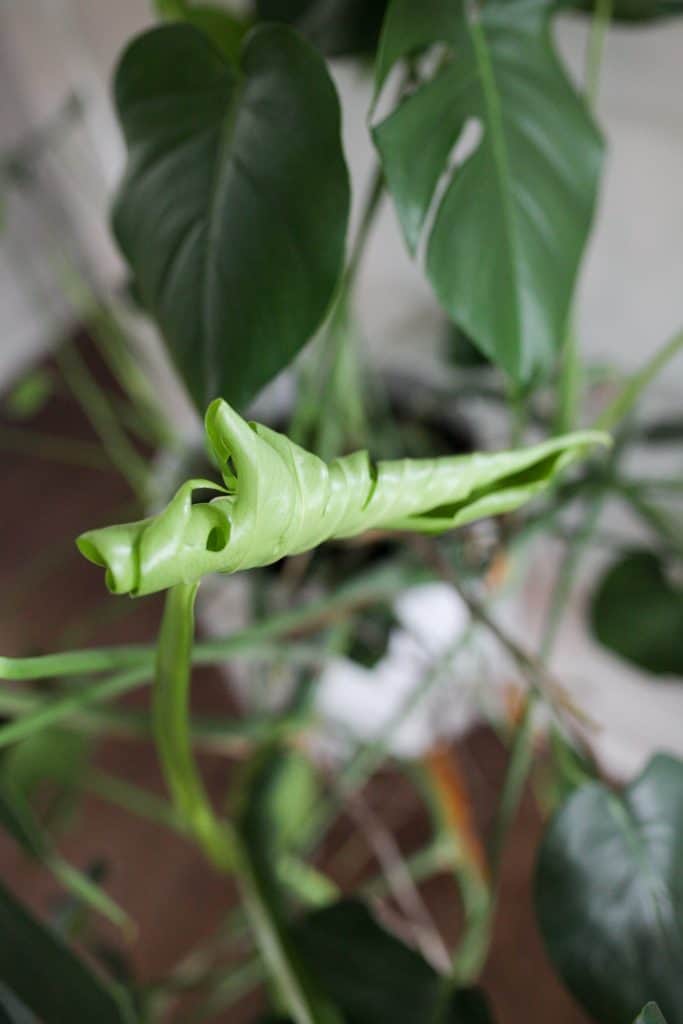
Yellow leaves can also be a sign of overwatering it. Be sure to let your monster’s soil dry out before watering it!
You leaves are turning brown and crispy on the edges or drooping
If you see your monstera either drooping or getting crispy on the edges, there’s a very good chance it is underwatered. Be sure you’re watering it enough so it doesn’t die!
Your monstera leaves are dropping
You may notice that your monstera leaves drop from time to time. Don’t freak out! This is a normal occurrence for almost all plants! Monstera plants will drop old leaves so they can produce new leaves.
Monstera Propagation
Check out this post for multiple ways to propagate your monstera along with step by step instructions and video!
I recently propagated my monstera by stem cuttings. I like to try out methods first before sharing them with you all so I can actually know what I’m talking about! 😉
This was seriously the easiest and quickest process. Basically all you need to do is cut the bottom of a stem of a healthy (but not too large) stem. I tried to do a couple that had 3 leaves on them. Be sure to cut beneath the node (the brown bump). That is where the roots will come from.
After you cut it, you’ll likely lose one of the leaves depending on where it is cut. That’s ok! Simple fill up a vase or pot with some water and put them in. Be sure to completely cover the node with water.
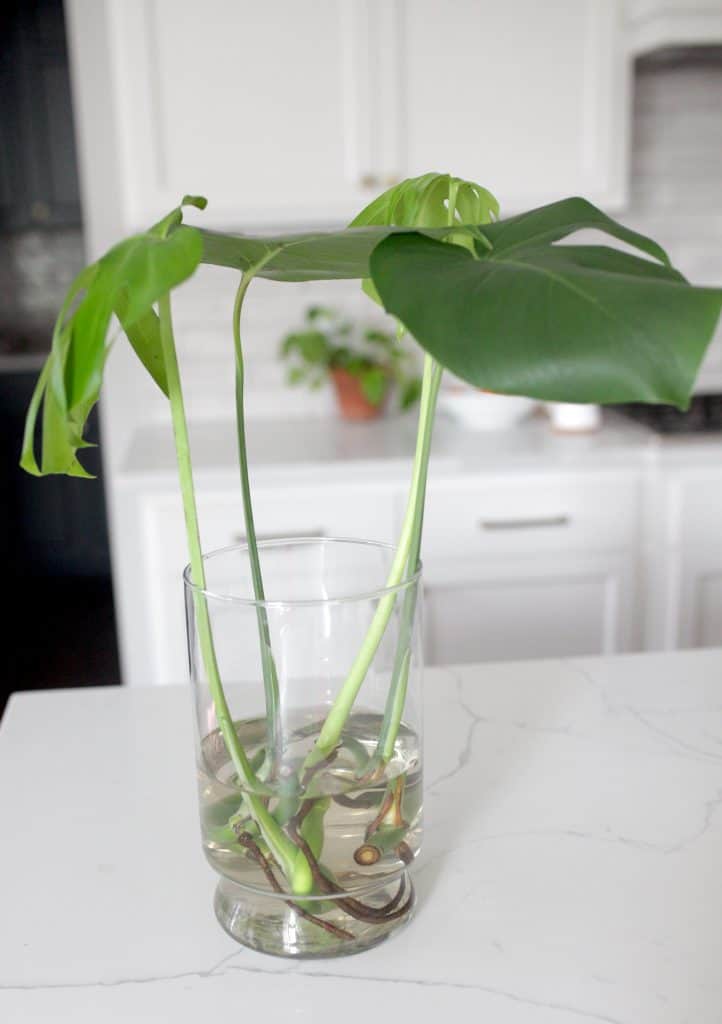
You could also put them directly in soil instead of doing water. I personally like to see the roots grow before potting it. That way I know they’re actually going to survive once I put it in a pot!
Switch out your water about every week or so. This will encourage new roots to form. Mine grew roots in just a few weeks so it’s a super quick and easy process. I ended up leaving my monstera clippings in water for so long that I even got new growth and fresh leaves popping out!
Another way to propagate your monstera is through it’s aerial roots. Simply cut the stem of the plant below the aerial roots. Put that in the water and the aerial root should start producing it’s own set of roots!
And there you go!
I hope this post helps you know everything you need to know about Monstera Plant Care so you can add one to your home! Just remember, give them bright indirect light and not too much water and they should be very happy! They’re a very easy plant that create quite a statement in your home. I highly recommend them!
As you’re looking for more fun, be sure to check out my fiddle leaf fig tree care posts! This is another beautiful large leaf plant that is a great next step after you’ve mastered the Monstera.
As always, thanks for reading and sharing!
Want more monstera fun? Head to one of these!

